Right-of-way in the parking lot in British Columbia
Parking lots in British Columbia are not a joke; but only the second most common place where collisions happen, only after intersections. It’s obviously important to understand right-of-way in the parking lot, how to drive safely in parking lots, and who should yield to who. In this article, we’ll dive into the rules, both for drivers yielding to each other, and of course, pedestrians, as well. Let’s take a look at the British Columbia laws and some common scenarios.
Question from a reader
Question : I am driving out of a parking lot. Several meters ahead of me, the back up lights on car in a parked space come on. Do I continue driving forward past the car, which is obviously in reverse, as I have the right of way. Or do I stop and allow the car with the back up lights to reverse out of its space?
Similarly if I am backing out of a parking space when should I put my vehicle into reverse (lighting the back up lights)…..only when I see there are no other vehicles behind me? I have a friend who will not pass a vehicle in a parking lot if the vehicle has the back up lights on. Better safe than sorry is their approach. I am wondering what is correct.
Parking lots are technically private property
The first thing to realize is that parking lots are private – not public – property. Therefore:
- Drivers use them as a guest of the property owner
- Private property owners set rules, and by parking there, drivers agree to them
- Common rules include who can use a parking space, how long drivers may park there, and when the parking lot might be closed to the public entirely
Motor Vehicle Act British Columbia Laws
Here is what the actual law (British Columbia Motor Vehicle Act) says about parking on private property, as well as rights when reversing a vehicle regardless of location:
Parking on private property
192 (1)If a motor vehicle or trailer is left without the occupier’s consent on private property in a municipality, treaty lands or Nisg̱a’a Lands or for a period exceeding 72 hours on private property not in a municipality, treaty lands or Nisg̱a’a Lands, the owner of the motor vehicle or trailer is deemed to have authorized and empowered the occupier to be the owner’s agent for the purpose of towing it to a place of storage and of storing it.
(2)The agent has a lien against the motor vehicle or trailer for all reasonable advances made or charges incurred in connection with the towing and storing of it in the course of the agency.
(3)The procedure respecting enforcement of the lien must be governed by the Warehouse Lien Act
Caution in backing vehicle
193 The driver of a vehicle must not cause the vehicle to move backwards into an intersection or over a crosswalk, and must not in any event or at any place cause a vehicle to move backwards unless the movement can be made in safety.
Beautiful British Columbia Motor Vehicle Act
“Highways” are every road
The other thing to consider is that, according to the beautiful British Columbia Motor Vehicle Act, parking lots are included in the definition of a “highway.” Legally speaking, in laymen’s terms, all roads are highways.
Therefore, all of the usual “rules of the road” that you normally follow would apply in parking lots, too. So when wondering about the right-of-way in the parking lot, just picture yourself on any normal road to imagine the appropriate answer.
“highway” includes
(a)every highway within the meaning of the Transportation Act,
(b)every road, street, lane or right of way designed or intended for or used by the general public for the passage of vehicles, and
(c)every private place or passageway to which the public, for the purpose of the parking or servicing of vehicles, has access or is invited,
but does not include an industrial road;
Beautiful British Columbia Motor Vehicle Act
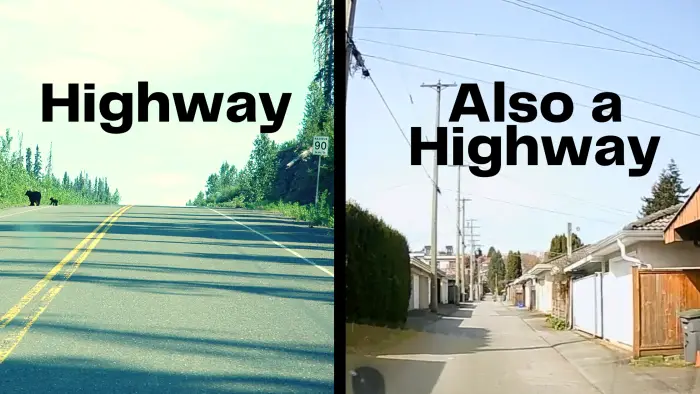
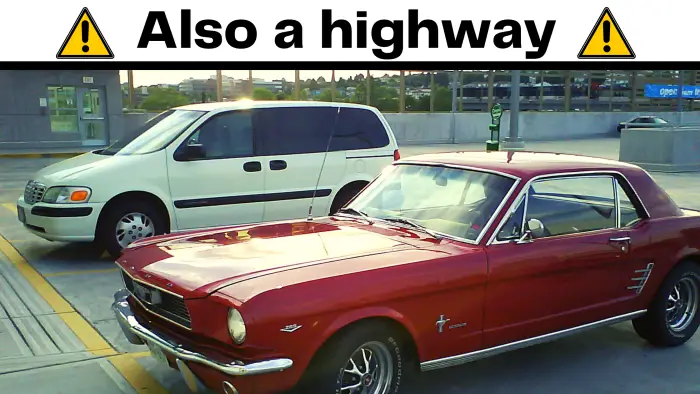
Speed limits in parking lots
Many parking lots will have posted speed limits. If a municipality, city, or town has speed limits for lanes in their traffic bylaws, then the maximum speed in a parking lot is 20 km/h. There may or may not be a speed limit sign posted, but the law is nevertheless valid.
(8)A municipality may by bylaw direct that the rate of speed at which a person may drive or operate a motor vehicle in the municipality on a lane not exceeding 8 m in width must not be in excess of 20 km/h.
Beautiful British Columbia Motor Vehicle Act
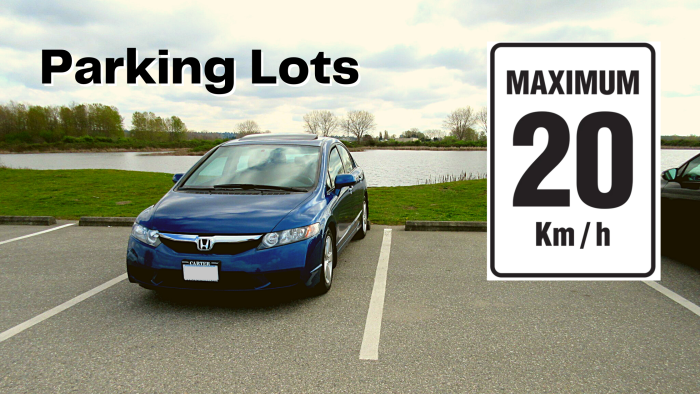
Pedestrians in the parking lot
What do the right-of-way in the parking lot laws say about pedestrians in parking lots, and rights between vehicles and pedestrians?
Modern parking lot designs seem to aim to fit the maximum amount of vehicles possible into the available space. This somehow doesn’t seem like the best idea when you realize that once drivers (and possibly the rest of their families) exit the vehicle, they suddenly morph into pedestrians.
According to the beautiful British Columbia Motor Vehicle Act, drivers are to use due care to avoid collisions with pedestrians on any “highway,” which of course includes parking lots.
Duty of driver
181 Despite sections 178, 179 and 180, a driver of a vehicle must
(a) exercise due care to avoid colliding with a pedestrian who is on the highway,
(b) give warning by sounding the horn of the vehicle when necessary, and
(c) observe proper precaution on observing a child or apparently confused or incapacitated person on the highway.
Beautiful British Columbia Motor Vehicle Act

When pedestrians must yield to vehicles
The beautiful British Columbia Motor Vehicle Act also indicates that pedestrians who cross the road or “highway” not in a crosswalk must yield the right-of-way to vehicles.
Crossing at other than crosswalk
180 When a pedestrian is crossing a highway at a point not in a crosswalk, the pedestrian must yield the right of way to a vehicle.
Beautiful British Columbia Motor Vehicle Act
So, yes, it seems that drivers must watch out for pedestrians in the parking lot, and pedestrians must also watch out for vehicles. This is all kind of common sense. But what about drivers yielding to other drivers in the parking lot? Let’s take a look at a few common examples.
Right-of-way in the parking lot: Drivers exiting a parking lot
According to this ICBC crash example, any driver who is exiting any kind of parking lot, lane, driveway, or alley must yield to the traffic that is already on the street. If there was a collision, between a vehicle exiting a parking lot, and a vehicle merely driving down the road adjacent to the parking lot, it would be the vehicle exiting the parking lot who would be found 100% at fault for any collision. Read more on our blog: Emerging from a lane, driveway, or parking lot.
Emerging from alleys
176 (1)The driver of a vehicle in a business or residence district and emerging from an alley, driveway, building or private road must stop the vehicle immediately before driving onto the sidewalk or the sidewalk area extending across an alleyway or private driveway, and must yield the right of way to a pedestrian on the sidewalk or sidewalk area.
Beautiful British Columbia Motor Vehicle Act
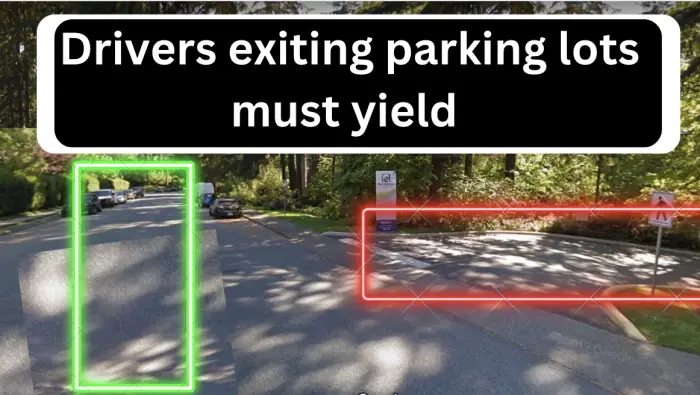
Parking lot main lane and feeder lanes
In parking lots, there tend to be main lanes and feeder lanes. The main lane is the lane that leads directly to the road. Feeder lanes are lanes that are approaching the main lane. Drivers who are driving in the feeder lane should yield the right-of-way to drivers already driving on the main lane.
In collisions between a driver on the main lane and a feeder lane driver, the driver on the feeder lane would be found 100% at fault for any collision, according to ICBC. In other words, if you’re not the driver driving on the main lane, yield the right-of-way in the parking lot.
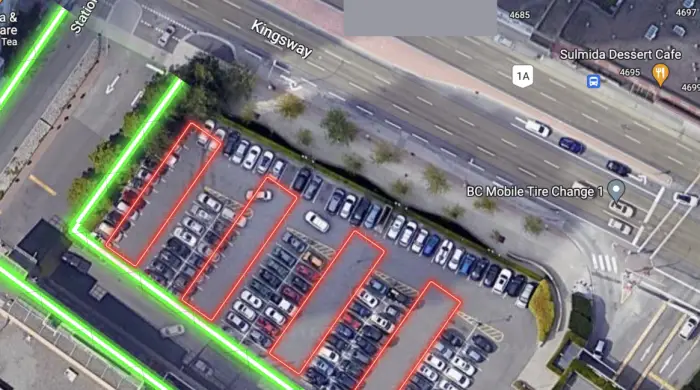
Drivers reversing from a parking spot
If a driver is reversing from a parking spot, and another driver is driving past, who should yield? Right-of-way in the parking lot rules indicates that drivers who are backing should yield. In a collision where one driver was backing and another was simply driving past, the backing driver would be found 100% at fault if there were any collisions.
This is one of the reasons I would always recommend reversing into a parking space rather than reversing out of it. At least if you reverse into it, you can check out the space and get a visual of where you’re about to reverse right before you reverse. If you drive forward, and back out, it forces you to back into a space where the environment may be constantly changing, and visibility diminished.
Caution in backing vehicle
193 The driver of a vehicle must not cause the vehicle to move backwards into an intersection or over a crosswalk, and must not in any event or at any place cause a vehicle to move backwards unless the movement can be made in safety.
Beautiful British Columbia Motor Vehicle Act – Caution in backing a vehicle
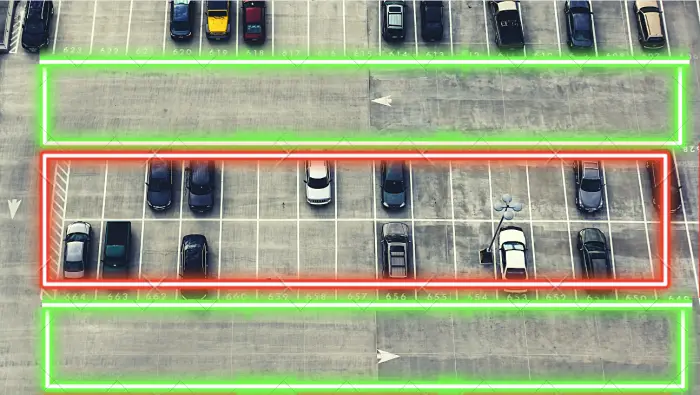
Reversing from a parking spot and reversing in a lane
Sometimes, collisions occur when one driver is reversing from a parking spot and another driver is reversing in the lane (main lane or feeder lane). Since all drivers must not reverse their vehicles unless it can be done safely, both drivers would be at fault for a resulting collision.
The driver of the vehicle backing out of the space would be found 75% responsible for the collision, and the other driver backing in the lane would be found 25% responsible, according to this ICBC crash example.
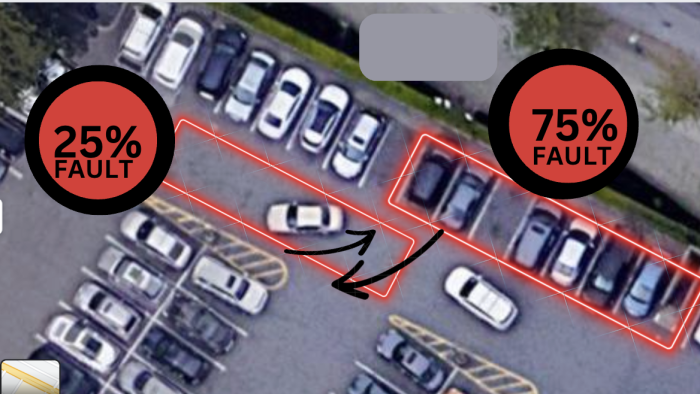
Two or more drivers reversing from parking spots at the same time
This is a common right-of-way in the parking lot situation: two drivers are both attempting to reverse out of a parking spot at the same time, and as silly as it may sound, it does happen. So, who would be at fault? Well, both of them, according to this ICBC crash example. Each would be found 50% at fault. Another good reason to reverse into your parking space, rather than reverse out of it. Read more on our blog: Reverse Stall Parking 101 for Beginners.
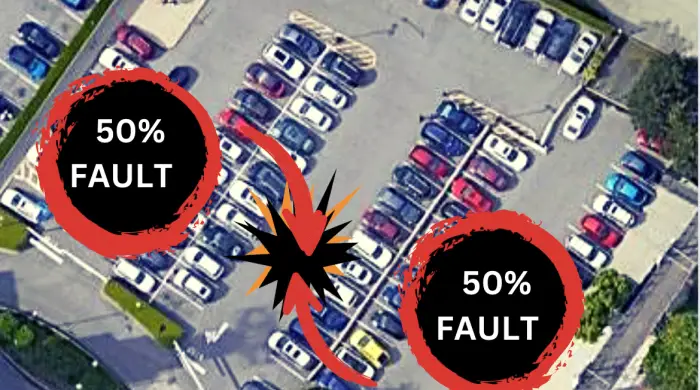
Conclusion
Just like the rest of driving, right-of-way in the parking lot can be confusing for many people. In addition, you can’t really expect that other people know what to do, or count on other people doing the right thing.
To make things safer, always “err on the side of caution.” You can also make your parking lot experience safer by reversing into the space so that you don’t need to reverse out.
Also, be prepared to honk your horn to alert an oblivious driver to your existence; that is much better than silently doing nothing while you watch them cluelessly plow into your vehicle. Check out my article on how to be a defensive driver and actively prevent collisions to learn more.
People should be looking backward while they are backing, but do they? Maybe they do, maybe they don’t. Considering that parking lots are the #2 most common location for collisions to happen, it’s always good practice to remain on high alert in parking lots.
Oh, and to actually answer your questions… You can stop and allow the car to reverse if you like, depending on the situation behind you. Or, you can continue driving – since you should be given the right-of-way in this scenario – and cover your horn to be ready to alert the driver to your presence, asking them to stop and yield until you are past if they don’t seem to notice you.
You can put your vehicle into reverse, activating the white reversing lights whenever you think it’s an appropriate time. It’s going to depend a lot on the particular parking lot and situation. Sometimes it’s a good idea to let people know what you want to do, otherwise, they aren’t usually psychic, and in busy parking lots, other drivers may be able to help you out. Driving is a team sport, so never be afraid to communicate your intentions.
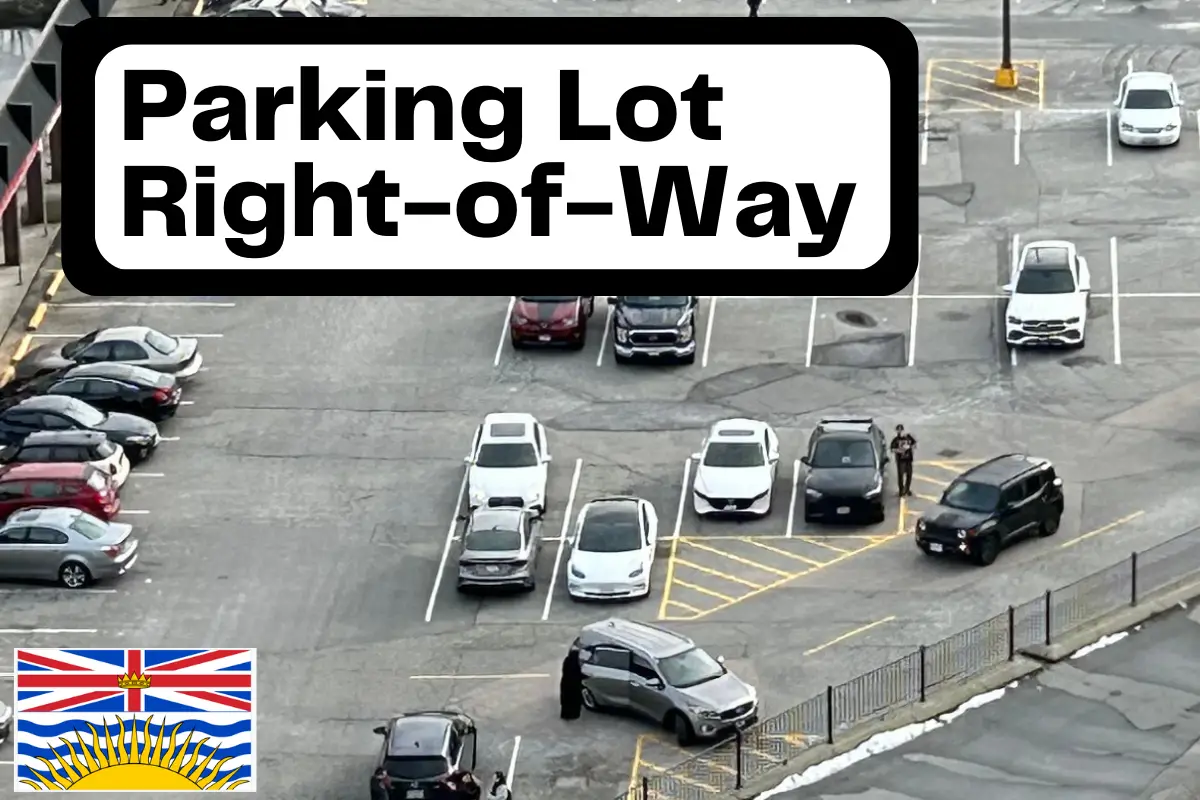
A woman was driving across the white lines in a parking lot not bothering to use the lane that was empty, that most people drive in before parking. Driving across the white lined stalls horizontally. It was totally unclear to me where she was going and why she was driving through the stalls this way. So I tried to take the first stall away from her coming from the feeder lane that connects to the main road. But she tried to cut me off then parked infront of me also crossing the white lines on a vertical. Then got out and mouthed me off as if she had some sort of right of way. Firstly, I was entering the lot from the road. So do I not have the right of way? Secondly, I took the first stall available while she drove horizontally through many empty stalls. Thirdly, I always thought pulling through white stall lines was illegal and you’d be at fault if you hit anyone using the parking lot properly.
when exiting a main road you appear on a road that allows you to access the parking lot, one road allows you to drive across the outside of the parking lot and another that allows you to enter the parking lot and they meet at a intersection (but not legally a intersection since theres no stop signs) when theres a accident (tbone) whos at fault the person drive across the outside of the parking lot or the person trying to enter into the parking lot, heres a diagram if it helps with what im trying to explain (the road is not a main road< its the access road to get to the parking lot)
I parkihng I
I lot I
—————– I– –I—————–
road road
——————–I I — ——————–
I road I
I I
Hi I have no idea what you mean, can you let me know the name of the streets?
Reading through the comment and scenario’s, I see this sort of thing happens more regularly than I though, dealing with a situation where our vehicle was clearly backing out of parking stall to a parking lot road way, another car came into the road and (admittedly the other driver said) wasn’t paying close attention and hit our vehicle, ICBC is still holding the reversing vehicle at fault – what? seriously!
I have read the B.C Motor Vehicle Act on this and read about on the ICBC site – but really, how is this on any level rational? It is not!
This loop hole is allowing people NOT to use any sort of cognitive thinking and get away with being ignorant and I think some of them even look for these situations out in order to file claims to have previous damages to their car fixed or worse, injury claims (only saying it wouldn’t be beyond some) and they won’t be denied in accordions to the rules no matter that the negligence was full on their part.
I read all about how you should back into a parking stall, really how does that help the situation, people will do the same stupid move and drive behind you, so how does that help, you are still going to be a fault according to rules.
I have driven for many years and I don’t know when the common decency rules of the road changed to a level that is totally unexpectable – SOMETIMES YOU ARE NOT FIRST
But if you run into somebody, even if they are perpendicular to your vehicle, while backing into a parking spot you are at 100% fault! Apparently.
I backed into a parking space at the Walmart in Port Coquitlam, when another driver stopped me and said it was illegal in Canada to back into a parking space. Unless there are specific signs that says “no backing into spot”, it’s allowed, right???
Hi, there is no law that says that. This is from the motor vehicle act on backing, this is our law on backing :
Caution in backing vehicle
193 The driver of a vehicle must not cause the vehicle to move backwards into an intersection or over a crosswalk, and must not in any event or at any place cause a vehicle to move backwards unless the movement can be made in safety.
So as long as it is safe… you are allowed to reverse into a parking spot.
But if you are backing up into a parking spot and a vehicle comes perpendicular to you and you hit them you are 100% at fault. Unless a police officer has issued the forward moving vehicle a ticket for being an idiot! The forward moving vehicle can see everything in front of them. The reversing vehicle cannot see everything. The fault should be on the forward moving vehicle that obviously isn’t paying attention to the vehicle already there and reversing. That vehicle should have the right of way. Period. I believe it’s called following to close to the vehicle in front of you.